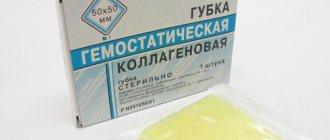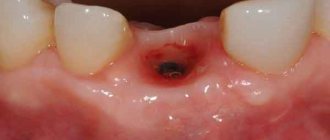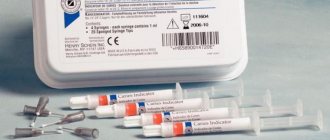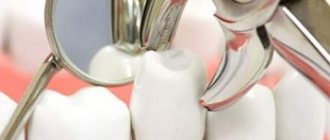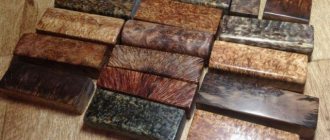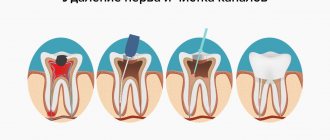Indications
Alveolar compresses after tooth extraction. “Alvostaz” (sponge) are hemostatic collagen cubes measuring 1X1 cm soaked in an appropriate solution.
Ingredients : eugenol, iodoform, thymol, calcium phosphate, lidocaine, butyl paraaminobenzoate, propolis.
Properties " Alvostaz " is a special remedy for the prevention and treatment of alveolitis. Alvostaz injected into the alveolus quickly relieves inflammation and pain. The drug exerts its effect for several hours, then gradually dissolves in the tooth socket. The medicinal composition does not cause inflammation of the oral mucosa. When using the material as a prophylactic agent, the drug promotes painless healing of the tooth socket in the shortest possible time.
Packaging Jar of 30 sponges
Alvostaz instructions
After removing a tooth or root, it is necessary to clean the hole.
In order to remove granulation or infected dead tissue, detached from the root of the perihilar granuloma and bone fragments, the hole should be washed with warmed saline.
Use a pipette to suck out the washing liquid from the well and isolate the well. Remove a small amount of the tampon from the jar with tweezers and carefully place it into the hole. You can apply a dry swab over the Alvostaz tampon.+
The patient should be warned that the tampon will gradually be torn out of the socket over time. You should not put stitches on the tampon. For difficult-to-heal holes, the tampon can be replaced with a new one several times.
Packaging: jar of 30 sponges.
Indications
To prevent inflammatory complications after surgical interventions in the oral cavity, alveolar compresses after tooth extraction; treatment of alveolitis and periodontal abscess; filling a periodontal pocket after local anti-inflammatory therapy or curettage for antiseptic treatment.
Ingredients: metronidazole, chlorhexidine, dexamethasone, conductor, flavoring, collagen cubes.
Properties "Alvostaz" (sponge No. 2) with metronidazole and chlorhexidine is a special product for use in surgical dentistry and ontology. Contains a composition of drugs that are bactericidal and have fairly high activity against many pathogenic microorganisms. Dexamethasone is a corticosteroid that has the ability to significantly reduce the number and severity of possible painful reactions. Without local toxicity, the drug does not cause the formation of ulcers on the mucous membrane.
Packaging Jar of 30 sponges
Alvostaz sponge: purpose and use in dentistry – Dentists Club
The most common uses of a sponge in dentistry are:
- during surgical interventions, especially when deterioration is detected;
- treatment of alveolitis, with inflammatory gum disease of a purulent nature;
- for quick healing of wounds after tooth extraction;
- preventing gum inflammation;
- antimicrobial effect when removing tartar from the periodontal pocket.
The sponge is small and looks like a sponge. After tooth extraction, alvostasis flagella are placed in the socket and allow bleeding to stop immediately. Serves as a disinfectant, antiseptic, relieves pain and eliminates inflammation, prevents the possibility of gum inflammation.
The medications included in the drug for the most part do not cause allergic reactions and are characterized by the absence of irritants for the oral mucosa and are non-toxic. People with a high degree of sensitivity to iodine in the composition should use the sponge with caution. Before use, it is worth checking if you have an individual intolerance to eugenol.
on this topic
How to care for your gums after tooth extraction and which methods of dental implantation and prosthetics are preferable to others - discussion of important issues in the “Live Healthy!” program:
Independent use of the product, without a doctor's prescription, is not recommended. If it has been prescribed, then it should be used strictly according to the instructions. The packaging in which the sponges are stored should not be opened in advance so as not to disrupt the healing properties of the plates.
Types of gg
There are two main types of sponges - those made from donated blood and those made from blood, tendons, blood, bones of cattle. The blood contains the following active components, such as thrombin, thrombokinase, and salts. It is thanks to these substances that the healing properties of GG are ensured.
Antibiotics for tooth extraction
Based on additional components, sponges are divided into:
- collagen (based on cattle bones and tendons);
- gelatinous (contains only livestock bones);
- amben (with elements of human blood plasma, sold only with a doctor's prescription).
GG may contain Furacilin, Nitrofural, boric acid and other medicinal components. Depending on the composition of GG, you can find products in pharmacies in different packages and with different names. As a rule, these are sealed blisters with one plate. Ambien tampons are packaged in dark glass vials.
Hemostatic sponge alvostasis
In addition to the jar with medicinal cubes, there is a hemostatic sponge with a similar effect. It looks like a porous plate, dark yellow in color with a faint smell of vinegar. This is a pressed powder of medicines:
- collagen;
- nitrofural;
- 2% substance-solution;
- Boric acid.
We invite you to familiarize yourself with Kamistad baby gel 10 g
The size of the plates is from 50 to 90 mm, in the form of a square. Dry porous elastic structure, perfectly absorbs liquid. Plates are used for open bleeding, as well as internal bleeding, when blood does not flow out. This is typical when organs located in the abdominal cavity are damaged.
The hemostatic sponge does not need to be removed; it dissolves independently in the human body. This will ensure the safety of the surgical procedure. Complete dissolution of the plate occurs after 14-28 days. The medicinal composition of the sponge accelerates wound healing and acts as an antiseptic.
But there are also contraindications to the drug.
There should be no individual intolerance to the drugs included in the sponge. The plates should not be used to stop arterial bleeding or purulent wounds. Hemostatic sponge alvostasis
After removing the sponge from the package, it is applied to the wound and held for a couple of minutes. After soaking in blood, the plate adheres to the body and does not require special fastening with a bandage. To enhance the effect, the plate is moistened with a thrombin solution.
Hemostatic sponge in the gum socket after tooth extraction - instructions for use in dentistry
A hemostatic sponge is an effective hemostatic agent that is widely used in medicine, including often used in dentistry. It has virtually no contraindications; it quickly stops the flow of blood from the wound and protects the damaged area of the body from external destructive influences, promoting speedy healing.
What is a sponge for?
The thing is that for “healthy” healing, the postoperative hole must be “closed” with a blood clot (thrombus).
If this does not happen, the wound will heal much more slowly, and the likelihood of complications increases several times.
Thus, the formed blood clot is a kind of biological bandage that does not allow saliva containing pathogenic microorganisms to “attack” the empty socket.
But there are times when after surgery a blood clot does not form (dissolves), and blood begins to flow from the wound. Most often, this abnormal phenomenon is associated with damage to bone tissue during surgery. But along with this, there are other reasons:
- bleeding disorders;
- active inflammatory processes in the postoperative wound (on the gums);
- injuries of large vessels;
- damage to the blood clot itself, blocking the hole;
- taking certain medications;
- non-compliance with the dentist’s recommendations for caring for the oral cavity in general and the wound in particular after extraction.
Pharmacies offer a wide range of GGs, which contain medications.
It is to eliminate postoperative bleeding from the socket that a hemostatic sponge (hereinafter referred to as HS) is used.
GG is a soft elastic porous plate with a faint odor of acetic acid. After the hemostatic sponge is inserted into the hole, it absorbs liquid, swells, and increases in size. As a rule, GGs are produced in 2 standard sizes - 50 X 50 mm, 100 X 100 mm.
We invite you to read How to return a tax deduction for dental prosthetics
Since this product has a characteristic porous structure, it can absorb a volume of liquid 30-40 times larger than its own. At the same time, the collagen sponge does not allow the formed protective blood clot to dissolve (thanks to the Ambien present in its composition).
Instructions for use
The hole created due to the extraction of a diseased tooth needs careful treatment. Infection must not be allowed to enter the cavity of the gums. The tissue where the process of cell death has already occurred is removed. Be sure to rinse the hole with warm saline solution and remove the remaining bone fragments.
Gauze swab for drying the hole
Before placing the Alvostaz sponge in the hole, the recess must be dried. This can be done either with a special suction or by using gauze swabs. Please note that cotton pads are not used to dry the hole, since after their use, lint remains in the hole, which is very difficult to remove.
After preparing the wound for treatment, you can use a sponge. It is necessary to remove the sponge soaked in the medicinal solution from the jar using tweezers and sterile disposable gloves. To avoid infection. A certain amount of the drug is placed into the recess. You can put a dry gauze swab on the sponge.
It happens that wound healing does not occur quickly. In this case, it is possible to repeat the procedure, that is, replace the sponge soaked in medicine with a new one. But this rarely happens. Usually one procedure is enough.
If there was a traumatic tooth extraction, then sutures are possible if necessary. Regardless of the fact that there is Alvostasis of flagella in the wound. There is no need to worry, since the cube placed in the hole has the property of resorption.
Instructions for using sponges in dentistry
Each package of the product contains detailed instructions for its use, which must be strictly followed to avoid complications. The use of a hemostatic sponge has its own nuances and features. A doctor should prescribe such drugs, taking into account contraindications and possible side effects.
How a hemostatic sponge is used in dentistry after tooth extraction: instructions for use of the material
The tooth extraction procedure always involves bleeding. It usually stops on its own after some time. However, in some cases, bleeding can take a long time, and it becomes necessary to forcibly stop it.
There are many ways to stop bleeding, for example, a hemostatic sponge has a good hemostatic effect. When using this product, it is necessary to take into account existing indications and contraindications.
How does it work?
The hemostatic agent is used topically for wound packing and has a wide range of actions, including:
- bleeding stop;
- protecting the wound from the development of bacterial infection;
- relief of foci of inflammation;
- relief from painful sensations;
- preventing swelling of the gum tissue;
- accelerating the healing of the hole.
The effect of the product continues for several hours after tooth extraction. After a certain time, the collagen sponge placed on the wound in the gum is completely absorbed.
We suggest you familiarize yourself with eating, drinking, smoking after tooth extraction
How to use a sponge correctly?
The sponge is used topically to pack the wound. It is necessary to cut off the required amount of the product and fix it in the wound cavity. After just five minutes, the sponge is completely saturated with blood, and then fits very tightly to the edges of the wound. If the bleeding does not stop, you can use another one; to do this, you need to put it on top of the first one.
After the bleeding has stopped, the sponge is fixed by suturing. To enhance the effect, it is moistened with a thrombin solution.
The sponge is not used for heavy bleeding that occurs when large vessels are damaged. The drug is contraindicated in patients with hypersensitivity to the components of the drug (for example, furatsilin).
When does the remedy dissolve?
During complex removal of wisdom teeth, several grooves from the roots remain in the socket, where the doctor places tampons from a hemostatic sponge.
To avoid infection and complications, the product cannot be removed by yourself; it remains until completely absorbed or is replaced naturally as the wound heals.
The maximum time for which a sponge can dissolve is 6 weeks.
Important! Sponges are not destroyed by cold water, but tend to dissolve at high temperatures, so the patient should refrain from hot food and drinks.
Drug interactions
The effect of the drug will be enhanced if thrombin is used to wet it.
Do I need to remove a self-absorbable tampon?
The hemostatic sponge does not need to be removed even after bleeding has stopped. There is no need to remove and change it; it remains in the wound until complete healing. The product consists of natural ingredients and can dissolve on its own within a month. If the wound heals quickly, the sponge is gradually pushed out and falls out on its own.
Attention! If the patient accidentally swallows a hemostatic sponge, there is no need to worry, it is harmless to the body.
Side effects and overdose
This drug can cause an allergic reaction to its individual components, in particular to furatsilin. In addition, the instructions say that when used, the wound may become infected.
It is not recommended to use the drug as a stopper for major vascular and arterial bleeding, as it will not have the desired effect. Cases of overdose are unknown to medicine.
How long does it take for alvostasis to resolve?
Alvostasis sponge No. 2. Main components: metronidazole and chlorhexidine.
A patient who realizes that there is a foreign body in his gum, in the form of an Alvostaz sponge, asks the question: “How long will it take for the sponge to dissolve?”
A sponge with a medicinal composition, inserted into the recess of the extracted tooth, begins its action immediately. Has an analgesic effect for up to several hours.
It will take three to five minutes to stop the bleeding, during which time the cube swells from absorbing blood and fits tightly to the walls of the gum. Thereby protecting the hole from possible infection.
Resorption itself can take up to several days. On average 14-21 days. The cube cannot be removed from the wound cavity.
Source: https://imdent.ru/gemostaticheskaya-gubka-v-lunke-desny-posle-udaleniya-zuba-instruktsiya-po-primeneniyu-v-stomatologii/
Indications
For the prevention of inflammatory complications after surgical interventions in the oral cavity, alveolar compresses after tooth extraction, treatment of alveolitis and periodontal abscess. Filling a periodontal pocket after local anti-inflammatory therapy or curettage for antiseptic treatment.
Ingredients: chloramphenicol, neomycin sulfate, chlorhexidine, dexamethasone, conductor, flavor, collagen cubes.
Properties "Alvostaz" (sponge No. 3) with chloramphenicol and neomycin is a special product for use in surgical dentistry and periodontology. The drug contains a composition of broad-spectrum antibiotics that are bactericidal and have fairly high activity against many pathogenic microorganisms and pathogens of purulent infections. The drug is active against strains of bacteria resistant to penicillin, tetracyclines, and sulfonamides. Dexamethasone is a corticosteroid that has the ability to significantly reduce the number and severity of possible painful reactions.
Packaging Jar of 30 sponges
